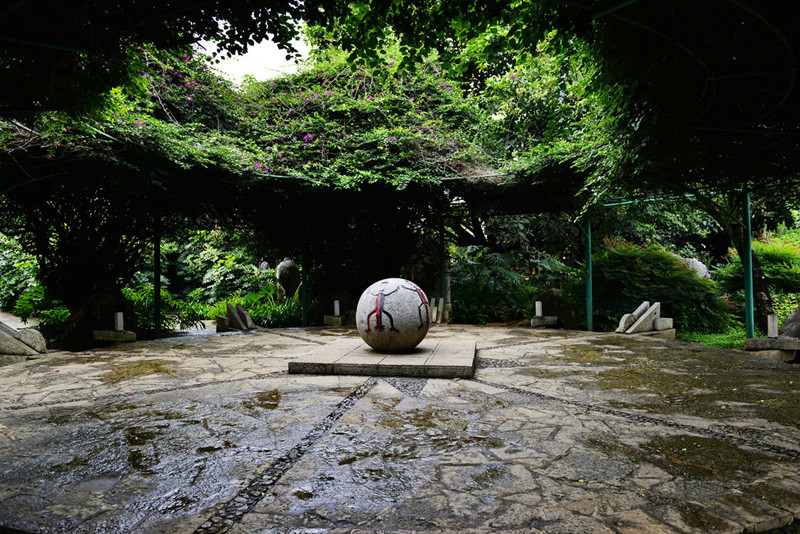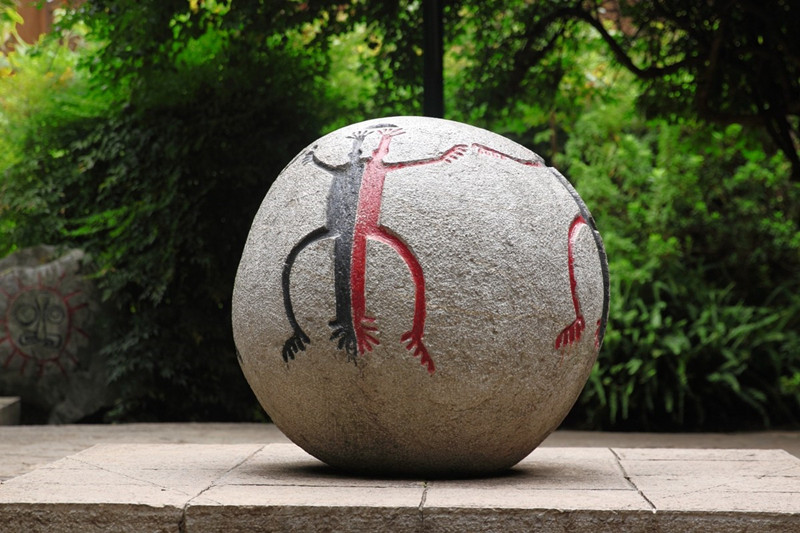
Village of Lahu Ethnic Minority in Yunnan Ethnic Villages, Kunming
The Lahu ethnic group (拉祜族) has a population of nearly 480,000 and is an indigenous ethnic group unique to Yunnan Province (云南). They primarily reside in the vast region along the Lancang River (澜沧江) within Pu’er (普洱) and Lincang (临沧) cities. They self-identify as a “nation that emerged from a gourd” and deeply believe in an ancient religion that venerates the “omnipotence of natural forces.” In the 19th century, Christianity was introduced to the border areas, and the Lahu people incorporated it into their own culture, leading to a widespread tradition of guitar playing and singing that continues to this day.
Traditional Lahu Village and Cultural Elements
The Lahu village (拉祜族寨) in the Yunnan Ethnic Village is closely connected to the Jino village (基诺族寨). Within the village, one can find traditional Lahu thatched houses (拉祜茅草房), communal halls (大公房), cattle sheds (牛棚), as well as a gourd square (葫芦广场) and a totem pole array (图腾柱阵). The gourd square is centrally located and resembles a large flat gourd, featuring stone-carved gourds and ancestral stone slabs, which are prominent attractions. In the Lahu village, the swinging of swings, the melodious sound of gourd pipes, and continuous guitar performances showcase the vibrant “harvest dance,” filled with joy and passion, reflecting the Lahu people’s way of life.
The main traditional festivals of the Lahu people include the Spring Festival (春节) and the Gourd Festival (葫芦节). The Spring Festival is the most grandly celebrated event and is referred to in Lahu as “Kuanihani.” The Gourd Festival, a newer celebration called “A Peng A Long Ni” in Lahu, takes place from April 8 to 10.
The Lahu people are known for their singing and dancing, often incorporating production-related movements into their performances. Their dance styles include the Lusheng dance (芦笙舞), swing dance (摆舞), and song-dance (跳歌). The Lusheng dance is a large collective dance performed during festivals, with a total of 136 folk combinations recorded.
Living Environment and Traditional Clothing
As one of the 15 unique ethnic minorities in Yunnan, the Lahu people primarily inhabit the areas along the Lancang River in Pu’er and Lincang. The Lancang Lahu Autonomous County (澜沧拉祜族自治县) in Pu’er has the largest concentration of Lahu people. Legend has it that the Lahu people emerged from gourds, which they regard as a national totem, and their clothing is often adorned with gourd patterns.
Distinctive Traditional Clothing
The traditional clothing of the Lahu people is unique and varies according to lineage and residence. Men typically wear collarless, right-over-left, long shirts, and wide-legged trousers, often topped with a black turban or a melon-shaped cap.
Lahu women (拉祜西妇女) wear black cloth headscarves, collarless short jackets decorated with colorful geometric patches at the chest and cuffs, and long skirts. The clothing of Lahu Na women (拉祜纳妇女) retains characteristics from northern clothing styles since their migration southward, featuring a long headscarf adorned with colorful tassels, collarless short jackets, and high-slit long robes lined with neat silver beads at the neckline. Their tube skirts are decorated with elegant and beautiful patterns, giving them a dignified and luxurious appearance.
Architectural Characteristics of Lahu Villages
The Lahu people thrive in the subtropical region at an altitude of around 1,000 meters along the Lancang River. Nestled among lush, dense forests, their homes are arranged in a picturesque manner. The Lahu people live harmoniously with their natural surroundings, utilizing rich forest resources to create bamboo and thatch houses and elevated bamboo stilt houses (桩上双斜面竹楼房).
Their residences adhere to stilt house architecture, with slight variations between the two types. The simpler design reflects the essence of “building nests from wood.” The more elaborate bamboo stilt houses, which resemble those in nearby Dai villages (傣乡), come in two different styles based on the area they occupy. The larger, long-corridor-style stilt houses are known locally as “communal houses” (公房) or “long houses” (长屋), representing the transition from extended families to smaller family units and preserving aspects of the original matrilineal marriage organization and customs of the Lahu.
Cultural Heritage and Culinary Traditions
The Lahu village in the Yunnan Ethnic Village features thatched houses, communal halls, churches (教堂), cattle sheds, and the prominent gourd square. The gourd square, which resembles a large flat gourd and features a group of stone-carved gourds at its center, symbolizes the ancestral worship beliefs of the Lahu, who believe that their ancestors originated from gourds.
The Lahu are one of the ancient ethnic groups in China, known historically as “the tiger-hunting nation.” The name Lahu means “to eat tiger meat roasted over a fire,” reflecting their traditional practice of cooking hunted game on the spot, which fostered a cultural preference for roasted meat. Lahu roasted meat is uniquely flavored and typically cooked by sandwiching salted and spiced meat between two bamboo sticks and roasting it slowly over a fire until golden brown, fragrant, and crispy. Alternatively, the meat can be wrapped in banana leaves and buried in the fire until cooked. This roasted meat is crunchy and delicious, often served with spicy seasonings for an appetizing experience.
Secret Recipe: Grilled Chicken Wings
For those who love barbecue, this authentic ethnic dish is a must-try!
“In auspicious days, we come together, singing the songs from our hearts, nourished by a sweet and happy life. The Lahu people sing passionately…” Dressed in traditional clothing, Lahu youths gather, playing guitars and singing folk songs. This scene is common in Lahu villages, resulting from the intersection of ethnic and global cultures.
In the past, Christianity was introduced by British clergy to the border areas. The Lahu people showed great interest in the expressive capabilities of the guitar, adapting it to their culture and becoming a people who sing and play their local songs. These Western musical instruments gradually became integrated into Lahu life. Along the fields and by the campfires, Lahu people express their emotions through guitar music, singing to friends or serenading their lovers. The heartfelt lyrics and beautiful melodies flow in a rhythm filled with “Lahu flavor.”
Weaving as a Cultural Expression
Historically, Lahu ancestors living in dense forests had very few individuals skilled in weaving; they often exchanged hunted animals for clothing with other ethnic groups. After settling down, the Lahu began to learn spinning and weaving. This craft has been preserved for over 600 years, maintaining the traditional cultural characteristics of the ethnic group throughout history. Today, local villages still uphold the traditions of weaving, dyeing, and making their own clothing. Lahu women utilize a simple weaving method with a long bench and a beam to create beautiful visions of life with colorful cotton threads in shades of black, red, blue, and green.
The Lahu people’s aspirations for beauty manifest in their clothing and decorative items. In the Yunnan Ethnic Village Lahu village, young women inherit the craftsmanship of their ancestors, sharing the unique cultural charm of their ethnic group with the world.




 7 Days GolfingTour
7 Days GolfingTour
 8 Days Group Tour
8 Days Group Tour
 8 Days Yunnan Tour
8 Days Yunnan Tour
 7 Days Shangri La Hiking
7 Days Shangri La Hiking
 11 Days Yunnan Tour
11 Days Yunnan Tour
 6 Days Yuanyang Terraces
6 Days Yuanyang Terraces
 11 Days Yunnan Tour
11 Days Yunnan Tour
 8 Days South Yunnan
8 Days South Yunnan
 7 Days Tea Tour
7 Days Tea Tour
 8 Days Muslim Tour
8 Days Muslim Tour
 12 Days Self-Driving
12 Days Self-Driving
 4 Days Haba Climbing
4 Days Haba Climbing
 Tiger Leaping Gorge
Tiger Leaping Gorge
 Stone Forest
Stone Forest
 Yunnan-Tibet
Yunnan-Tibet
 Hani Rice Terraces
Hani Rice Terraces
 Kunming
Kunming
 Lijiang
Lijiang
 Shangri-la
Shangri-la
 Dali
Dali
 XishuangBanna
XishuangBanna
 Honghe
Honghe
 Kunming
Kunming
 Lijiang
Lijiang
 Shangri-la
Shangri-la
 Yuanyang Rice Terraces
Yuanyang Rice Terraces
 Nujiang
Nujiang
 XishuangBanna
XishuangBanna
 Spring City Golf
Spring City Golf
 Snow Mountain Golf
Snow Mountain Golf
 Stone Mountain Golf
Stone Mountain Golf













